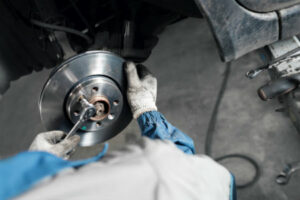
Brakes & Brake Repair
Do you need more runway than a jumbo jet to stop your car? If you answered yes it’s time to have your brakes inspected at your facilities.
Platinum Plus Auto Repair BRAKE EXPERTS
From the brake pedal to hydraulic brake fluid, brake master cylinder to power brake booster, drum brakes to disc brakes and electronic anti-lock brake sensors,Platinum Plus Auto Repair technicians know every part of your brake system inside and out and can perform brake repair on any make and model.
No wonder Platinum Plus is one of North America’s brake service leaders. With lifetime warranties, you can be confident we’ll always be there when you need us.
BRAKE WARNING SIGNS
You know you need brake repair when:
the brake dashboard light glows amber, indicating problems with the anti-lock brake system (ABS)
the brake dashboard light is red, indicating a system imbalance
the brake pedal is spongy or slow to respond
you hear grinding or constant squealing during braking
Any time you notice these or other symptoms, it’s a good idea to have your brakes checked. At Platinum Plus Auto Repair, if our inspection reveals you do need brake repair service, we will explain exactly what’s required, what’s optional and provide you with a written estimate before any work is done.
Our quality pads and shoes come with a Lifetime Guarantee. * Brake pads and shoes purchased with this guarantee are warranted for as long as you own your car. Just pay the labor.
See manager for limited guarantee terms.
Brake systems – more than you wanted to know.
Your vehicle’s brake system has one job – to stop your vehicle. But it takes several key components to deliver that singular end result. To bring a vehicle to a halt, three things are necessary: leverage, hydraulic force and friction. Leverage is supplied by the driver’s leg pressure and the brake pedal. The pedal is connected by levers and rods to the back of the power booster. The power booster uses either engine vacuum or a hydraulic pump to multiply and transfer the force of that leverage to the master cylinder. The master cylinder is the heart of your vehicle’s brake hydraulic system. It uses applied leverage to force a reservoir full of brake fluid through valves, steel lines and rubber hoses into hydraulic calipers and wheel cylinders. That hydraulic pressure is then used to help create friction.
For example, disc brakes use a hydraulic caliper fitted with brake pads to grab a spinning disc (or rotor). Drum brakes, on the other hand, have a hydraulic wheel cylinder that pushes a brake shoe against the inside of a spinning drum. Either design involves highly engineered parts and precise movement. The more force a driver applies to the brake pedal, the greater the stopping force that is applied at the wheels.
In addition to this primary braking system, most of today’s vehicles utilize an electronic Anti-lock Brake System. Using electronic sensors and high pressure pumps, under certain conditions, your ABS system can measure vehicle speed, wheel slip and brake force. Then it actually pumps the brakes for you during an emergency stop.
That’s why it’s essential to be proactive about testing overall brake components. And to know whether a brake component needs simply to be serviced or totally replaced.

Recent Comments